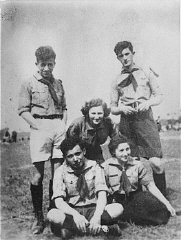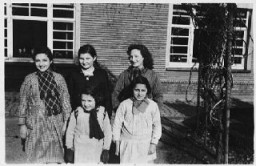<< Previous | Displaying results 1401-1450 of 6769 for "" | Next >>
On November 9–10, 1938, Nazi Party officials set off a series of violent pogroms against Jews in Germany and Austria. This event came to be known as the "Night of Broken Glass."
The so-called Nazi Euthanasia Program targeted for murder Germans with mental and physical disabilities. It claimed the lives of an estimated 250,000 people.
In July 1938, delegates from 32 countries met in Evian, France for a conference on the refugee crisis. The delegates expressed sympathy for the Jews who were seeking to flee Nazi persecution. Most countries, however, refused to admit more refugees.
On April 1, 1933—less than 3 months after rising to power—the Nazis staged a nationwide boycott of Jewish businesses. The boycott signaled the start of the Nazi movement to exclude Jews from all aspects of German soci...
With the end of World War II and collapse of the Nazi regime, survivors of the Holocaust faced...
In 1942, Aron Derman and Lisa Nussbaum escaped deportation from the Grodno ghetto with the help of Tadek Soroka, a non-Jewish Pole. Aron and Lisa—aged 19 and 15—joined the armed Jewish resistance. As partisans, they f...
With the end of World War II and collapse of the Nazi regime, survivors of the Holocaust faced...
With the end of World War II and collapse of the Nazi regime, survivors of the Holocaust faced...
With the end of World War II and collapse of the Nazi regime, survivors of the Holocaust faced...
During World War II, members of Zionist youth movements embraced leadership positions in ghett...

The Germans established Jewish Councils (Judenraete) in the ghettos during World War II. Jewish Councils were required to implement Nazi policies in the ghettos. This role meant impossible moral dilemmas. Council members had to decide wheth...
In summer of 1941, following the German invasion of the Soviet Union, the Nazis gradually occu...
Hadamar was one of six euthanasia killing facilities in the Nazi Euthanasia Program.
The "euthanasia" program targeted, for systematic killing, patients with mental and physical disabilities living in institutional settings in Germany and German-annexed territories. Historians estimate that the program claimed the lives of 250,000 men, women, and children.

We would like to thank Crown Family Philanthropies, Abe and Ida Cooper Foundation, the Claims Conference, EVZ, and BMF for supporting the ongoing work to create content and resources for the Holocaust Encyclopedia. View the list of donor acknowledgement.